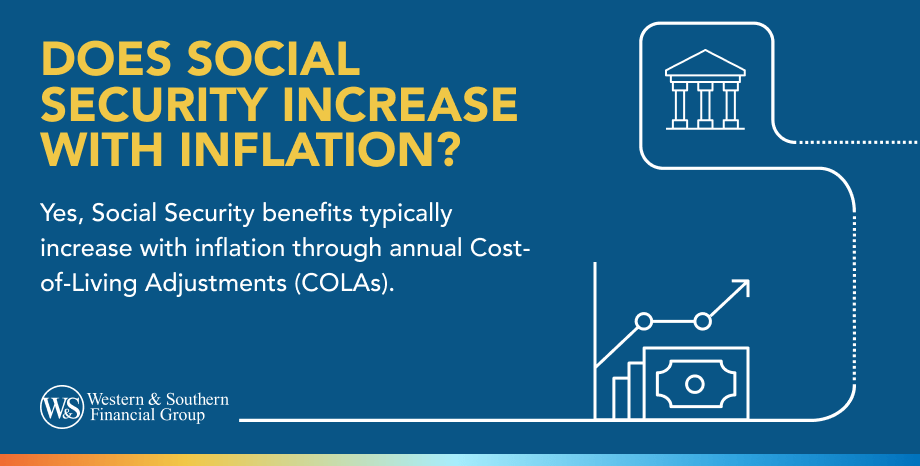

Key Takeaways
- The Social Security COLA is announced in mid-October and goes into effect in January of the following year.
- The COLA amount is based on the decrease in the CPI-W from the third quarter of the previous year to the third quarter of the current year.
- The COLA applies to retirement, disability, spousal, and survivor benefits.
- The 2024 COLA is 2.5%, which is part of a steady decline over the past few years.
- A higher COLA can lead to increased Medicare premiums and income taxes on benefits for some recipients, so it's important to plan for the net increase.
Steep price hikes are making it harder for many consumers to afford even basic needs, such as utilities, transportation and groceries. And they can be especially tough on retirees, many of whom may be on fixed incomes and must stick to a strict budget to make ends meet.
The surge in prices experienced in recent years has left many seniors wondering: Does Social Security increase with inflation? Fortunately for the program's recipients, the answer is a definitive yes.
Here's how the program determines its annual cost-of-living adjustment, or COLA, and when you can expect the next increase in your benefit.
When Does the Social Security COLA Take Effect?
The Social Security Administration (SSA), typically announces the annual cost-of-living adjustment, if any, in mid-October. The COLA is then applied to December benefits, which it pays out the following January.
To determine the COLA increase, the program uses an inflation number known as the Consumer Price Index for Urban Wage Earners and Clerical Workers, or CPI-W. The cost-of-living adjustment is equal to the percentage increase in the average CPI-W from the third quarter of the previous year to the third quarter of the current year. If there is no increase in the inflation figures, the SSA doesn't apply a COLA to the following year's benefits.
Based on the increase in the CPI-W from the third quarter of 2023 to the same period in 2024, the SSA announced a 2.5% cost-of-living adjustment.1 That change will be seen by recipients in their January 2025 payments.
Who Qualifies for the COLA?
The yearly cost-of-living adjustment, if any, doesn't just go to retirees — it also applies to those receiving spousal benefits as well as widows and widowers. People receiving disability benefits get the increased benefit as well.
The COLA also helps future beneficiaries who have delayed receiving Social Security. If you're already eligible to collect early retirement benefits but have yet to apply for them, any cost-of-living adjustments in the meantime will be tacked on to your future benefit. For example, if you turned 62 this year, but don't claim retirement benefits until 2027, any COLAs between now and then will be applied to your eventual monthly benefit.
Social Security COLA for 2025
While inflation has moderated slightly, consumers are still seeing the largest year-over-year price hikes since the early 1980s. As a result, the COLA for 2024 is 2.5%, down from 2023 with a 3.2%. If this trend keeps occurring, consumers could see a possible lower COLA in 2025.2
That may sound like welcome news to seniors and people with disabilities who depend heavily on Social Security benefits. However, even a historically large annual increase in payments may not be enough for some recipients to keep pace with rising prices.
Part of the reason has to do with the inflation metric that the program uses. The CPI-W measures the change in prices for various goods and services based on the spending habits of current full-time workers. As such, critics argue that it doesn't accurately reflect cost increases for retirees, who typically spend much more of their income on health care. In fact, consumers who are 65 years and older spend more than twice as much on medical costs — and those 75 and older spend nearly three times more on medical costs — than younger consumers, according to the National Committee to Preserve Social Security and Medicare.3
A relatively large increase in benefits could also have unintended consequences for certain recipients. For instance, people who receive substantial income from wages or investment income may have to pay taxes on their benefits for the first time — or see a larger share of their benefits become subject to taxes. Accordingly, filers who make between $25,000 (individually) and $32,000 (jointly) income may have to pay income tax on up to 50% of their benefits.4
Bottom Line
Keep in mind that receiving larger Social Security payments may also result in higher Medicare premiums for some participants. Therefore, it's important to plan for what the net increase in your benefit will be, not just the COLA itself.
An experienced financial professional can help explain how those changes will affect your benefits. Working together, you can create a comprehensive retirement plan that mitigates the effect of rising prices. If you feel you could benefit from a personalized look at your individual situation, don't hesitate to reach out for assistance.
Create a retirement plan that adjusts to inflation and helps you maximize your Social Security benefits. Start Your Free Plan
Sources
- Latest cost-of-living adjustment. https://www.ssa.gov/oact/cola/latestCOLA.html.
- Cost-of-living adjustments. https://www.ssa.gov/oact/cola/colaseries.html.
- The CPI-E: A better option for calculating Social Security COLAs. https://www.ncpssm.org/documents/social-security-policy-papers/the-cpi-e-a-better-option-for-calculating-social-security-colas/.
- Income taxes and your Social Security benefit. https://www.ssa.gov/benefits/retirement/planner/taxes.html.




























